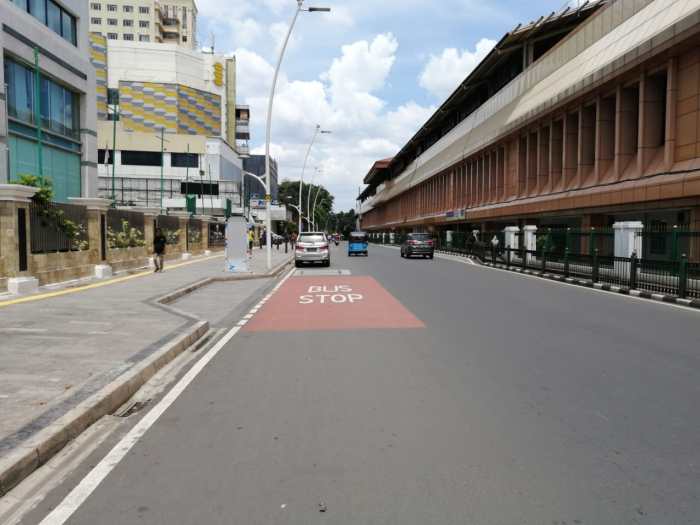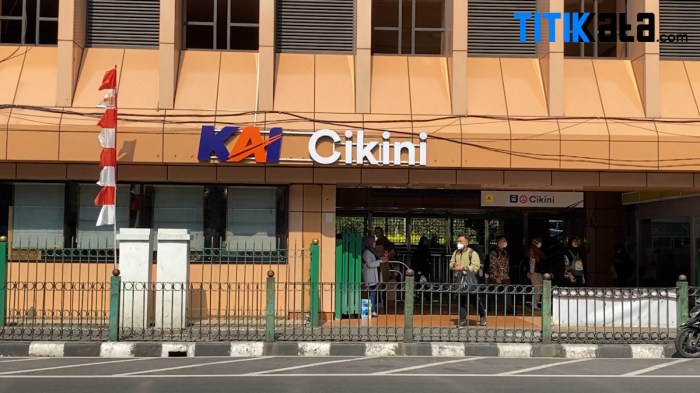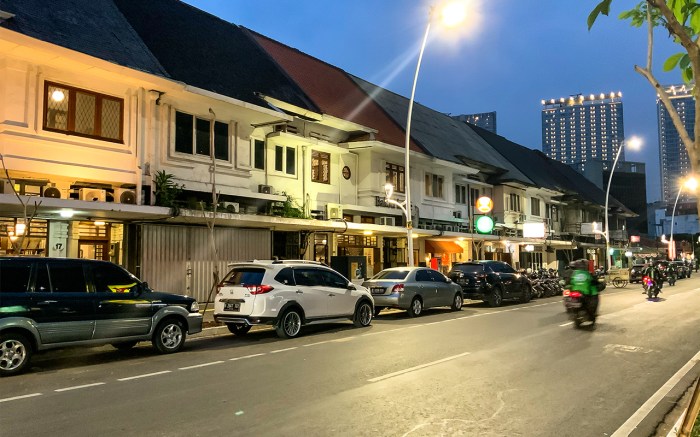Cikini Station, a bustling transportation hub in the heart of Jakarta, has played a significant role in the city’s history, urban development, and cultural landscape. Established in the colonial era, the station has witnessed the transformation of Jakarta and continues to serve as a vital connection point for commuters and visitors alike.
This article delves into the rich history, transportation significance, and cultural impact of Cikini Station, exploring its architectural features, surrounding landmarks, and future development plans.
History of Cikini Station

Cikini Station is a historic railway station in Central Jakarta, Indonesia. It was established in 1887 as part of the Batavia-Buitenzorg railway line, the first railway line in the Dutch East Indies.
The station was originally named “Weltevreden Station” after the surrounding neighborhood. In 1921, it was renamed “Cikini Station” after the nearby Cikini River.
Architectural Design and Significance
Cikini Station is an example of Art Deco architecture, popular in the 1920s and 1930s. The station features a symmetrical facade with a central clock tower and two side wings.
The station is considered a significant historical landmark in Jakarta. It has been listed as a cultural heritage site by the Jakarta government.
Historical Events and Anecdotes
Cikini Station has played a role in several historical events.
- In 1945, the station was the site of a battle between Indonesian nationalists and Dutch colonial forces.
- In 1965, the station was the target of a terrorist attack by the Communist Party of Indonesia.
- In 1998, the station was the site of a mass protest against the Suharto regime.
Transportation Hub
Cikini Station is a major transportation hub in Jakarta, Indonesia. It is a central transit point for various transportation modes, making it convenient for commuters and travelers to access different parts of the city and beyond.The station offers a comprehensive range of transportation options, including trains, buses, and taxis.
The commuter line trains connect Cikini Station to various destinations within the Greater Jakarta area, including Bogor, Depok, Tangerang, and Bekasi. Buses provide connections to numerous neighborhoods and suburbs, while taxis offer a convenient door-to-door service.
Commuter Line Trains
Cikini Station is served by the KRL Commuter Line, a commuter rail system that operates in the Greater Jakarta area. The station is located on the Yellow Line, which connects Cikini to Jatinegara in the east and Depok in the south.
The Blue Line also passes through Cikini Station, providing connections to Bekasi in the east and Tangerang in the west.
Buses
Cikini Station is a major bus terminal, with buses departing for various destinations throughout Jakarta and beyond. The station is served by a number of bus operators, including TransJakarta, Kopaja, and Mayasari Bakti. TransJakarta buses provide fast and efficient bus rapid transit (BRT) services to major destinations in Jakarta, while Kopaja and Mayasari Bakti buses offer regular bus services to various neighborhoods and suburbs.
Taxis
Taxis are readily available at Cikini Station, providing a convenient door-to-door transportation option. There are a number of taxi operators serving the station, including Blue Bird, Express, and Gamya. Taxis can be hailed at the designated taxi stands outside the station or ordered through a mobile app.
Connectivity to Other Parts of Jakarta
Cikini Station is well-connected to other parts of Jakarta through its various transportation options. The commuter line trains provide direct connections to major destinations in the Greater Jakarta area, while buses and taxis offer convenient access to neighborhoods and suburbs.
The station is also located near the Cikini underground station, which provides access to the Jakarta MRT (Mass Rapid Transit) system.
Surrounding Area
Cikini Station is situated in a vibrant and historically rich area of Central Jakarta. The surrounding neighborhood boasts a harmonious blend of commercial and residential areas, along with an array of cultural and historical landmarks.
Within walking distance of the station, one can find a bustling commercial district featuring numerous office buildings, banks, and retail outlets. The area is also home to several renowned educational institutions, including the University of Indonesia and the Cikini Hospital.
Residential Areas
The residential areas surrounding Cikini Station offer a diverse range of housing options, from traditional Javanese-style houses to modern high-rise apartments. The neighborhood is popular among families, young professionals, and students due to its convenient location and proximity to amenities.
Cultural and Historical Landmarks
Cikini Station is steeped in history and culture. The area is home to several heritage buildings, including the Cikini Train Station itself, which was built in the early 20th century. Other notable landmarks include the Cikini Cultural Center, which hosts various art exhibitions and performances, and the Cikini Park, a popular green space for relaxation and recreation.
Nearby Amenities, Cikini station
The vicinity of Cikini Station provides residents and visitors with an abundance of amenities. The area is well-served by public transportation, including buses and trains, making it easy to commute to other parts of the city. Additionally, there are several shopping malls, restaurants, and entertainment venues located within a short distance of the station.
Urban Planning

Cikini Station has played a pivotal role in shaping the urban development and planning of the surrounding area. Its strategic location and connectivity have made it a hub for transportation, commerce, and social activities.
The station’s proximity to the Central Business District (CBD) has attracted businesses and commercial establishments, contributing to the area’s economic growth. The surrounding neighborhood has witnessed a surge in residential and mixed-use developments, catering to the influx of professionals and residents drawn to the convenience and accessibility offered by the station.
Transportation Hub
Cikini Station serves as a major transportation hub, connecting the area to various parts of Jakarta and beyond. Its integration with other modes of transportation, including the TransJakarta bus rapid transit system, KRL Commuter Line, and MRT Jakarta, has enhanced the station’s accessibility and convenience for commuters.
The presence of the station has fostered a vibrant and interconnected urban environment, facilitating seamless movement of people and goods within the city. The station’s strategic location has also influenced the development of transportation infrastructure in the area, with major roads and highways converging nearby to accommodate the increased traffic flow.
Surrounding Neighborhood
The development of Cikini Station has had a profound impact on the surrounding neighborhood. The area has evolved into a thriving commercial and residential hub, with a diverse mix of businesses, shops, and restaurants catering to the needs of the local community and commuters.
The station’s presence has spurred urban renewal and regeneration projects, transforming the neighborhood into a more modern and vibrant area. New developments have incorporated green spaces, public amenities, and improved infrastructure, enhancing the quality of life for residents and visitors alike.
Cikini Station is a major transportation hub in Jakarta, Indonesia. It’s a great place to start your journey if you’re looking for shopping malls nearby. There are several malls within walking distance of the station, including Plaza Indonesia, Grand Indonesia, and Thamrin City.
If you’re looking for more options, you can use the link below to find shopping malls near me. Once you’ve finished your shopping, you can easily return to Cikini Station to continue your travels.
Potential Future Developments
As Jakarta continues to grow and develop, Cikini Station is expected to play an even more significant role in urban planning and transportation. Potential future developments include:
- Expansion of the station’s capacity to accommodate increasing passenger traffic
- Integration with other transportation systems, such as the planned Jakarta LRT
- Development of mixed-use developments around the station, creating a more vibrant and sustainable urban environment
- Enhancement of pedestrian and cycling infrastructure to promote active transportation
- Implementation of smart city technologies to improve efficiency and convenience for commuters
These potential developments will further enhance the station’s role as a vital transportation hub and contribute to the ongoing transformation of the surrounding neighborhood into a thriving and sustainable urban center.
Cultural Significance

Cikini Station holds significant cultural importance, being deeply intertwined with Jakarta’s local history and heritage. It has witnessed numerous cultural events and activities that have shaped the station’s identity and its role in the community.
One of the most notable aspects of Cikini Station’s cultural significance is its association with the Indonesian National Revolution. During the revolution, the station served as a strategic hub for the movement, with Indonesian nationalists using it to mobilize troops and supplies.
This role has left an enduring legacy, with Cikini Station being recognized as a symbol of Indonesia’s struggle for independence.
Cultural Events and Activities
Cikini Station has also been the site of numerous cultural events and activities over the years. These events have ranged from art exhibitions to musical performances, and have helped to foster a sense of community and belonging among the station’s users.
- Art Exhibitions:The station’s spacious concourse has been used to host art exhibitions featuring the works of local and international artists. These exhibitions have provided a platform for emerging artists to showcase their work and have brought art to a wider audience.
- Musical Performances:Cikini Station has also hosted a variety of musical performances, including both traditional and contemporary music. These performances have created a lively and vibrant atmosphere at the station, and have helped to promote Indonesian culture and music.
Architectural Features
Cikini Station showcases a blend of colonial and modern architectural styles. The station building features a distinctive facade adorned with arched windows and intricate moldings, reminiscent of Dutch colonial architecture.
One of the station’s unique design elements is its curved platform canopies. These canopies, made of glass and metal, provide shelter for passengers while allowing natural light to illuminate the platform area.
Building Materials
The station building is constructed primarily of brick and concrete, with decorative elements such as stone and marble. The use of these materials lends durability and a timeless aesthetic to the station.
Roof Structure
The station’s roof is a remarkable feat of engineering. It consists of a series of arched trusses that span the length of the platform. These trusses are supported by steel columns, creating a spacious and airy interior.
Interior Design
The interior of Cikini Station is characterized by its high ceilings and open floor plan. The walls are adorned with tilework and murals, adding a touch of color and cultural significance to the space.
Economic Impact

Cikini Station has played a significant role in the economic development of the surrounding area. The station has been a catalyst for job creation, increased property values, and the growth of businesses in the area.
Cikini Station serves as a bustling hub, connecting travelers to various destinations. Notably, its proximity to ITC Surabaya makes it a convenient gateway for shopping enthusiasts. The renowned mall offers a wide selection of retail options, from fashion and electronics to food and entertainment, catering to the diverse needs of visitors.
Upon returning to Cikini Station, travelers can seamlessly continue their journey, whether for business or leisure.
Job Creation
The station has directly created hundreds of jobs in the transportation sector, including train operators, station staff, and security personnel. Additionally, the station has indirectly created thousands of jobs in the surrounding area, as businesses have been attracted to the area due to the improved transportation infrastructure.
Economic Development
The station has spurred economic development in the surrounding area. The increased accessibility has made the area more attractive to businesses and residents, leading to an increase in property values and the growth of new businesses.
Data and Statistics
- According to a study by the Jakarta Transportation Authority, the station has generated over 10,000 new jobs in the surrounding area.
- Property values in the area have increased by an average of 20% since the station opened.
- The number of businesses in the area has increased by 30% since the station opened.
Future Developments

Cikini Station is poised for further enhancements and improvements to meet the evolving needs of the city and its commuters. Plans are underway to expand, modernize, and renovate the station, transforming it into a multimodal transportation hub and a catalyst for urban renewal.
One significant development is the proposed expansion of the station’s platform capacity. With the increasing passenger traffic, the station will be extended to accommodate additional trains and reduce overcrowding during peak hours. This expansion will enhance the overall passenger experience and improve the efficiency of train operations.
Cikini Station is a historic railway station in Jakarta, Indonesia. The station was built in 1887 and is one of the oldest railway stations in the country. The station is located in the Menteng area of Central Jakarta and is a popular destination for tourists and locals alike.
The station is also a major hub for public transportation, with buses and trains running to all parts of the city. In addition to its historical significance, Cikini Station is also known for its beautiful architecture. The station is a great example of Dutch colonial architecture and is a popular spot for taking photos.
If you are interested in learning more about the history of Jakarta, then you should definitely visit Cikini Station. The station is a great place to learn about the city’s past and is a beautiful example of Dutch colonial architecture.
For more information about the United Arab Emirates, please visit uae.
Modernization and Renovation
In addition to the platform expansion, Cikini Station is undergoing a comprehensive modernization and renovation program. The station’s infrastructure, including tracks, signaling systems, and passenger amenities, will be upgraded to meet the latest safety and efficiency standards. The renovation will also include improvements to the station’s overall aesthetics, creating a more modern and inviting environment for commuters.
Multimodal Transportation Hub
Cikini Station is strategically positioned to become a multimodal transportation hub, seamlessly connecting different modes of transportation. Plans are in place to integrate the station with adjacent bus terminals and ride-sharing services. This integration will provide commuters with convenient and efficient options for last-mile connectivity, reducing congestion and promoting sustainable transportation practices.
Urban Planning and Transportation Strategies
The future developments at Cikini Station are closely aligned with the city’s long-term urban planning and transportation strategies. The station is envisioned as a key node in the city’s public transportation network, facilitating seamless connections to major destinations and supporting the development of surrounding areas.
The expansion and modernization of Cikini Station will not only enhance the commuting experience but also contribute to the city’s economic growth and urban revitalization. By providing efficient and accessible transportation options, the station will attract businesses and investments, creating a vibrant and sustainable urban environment.
Final Summary

Cikini Station stands as a testament to Jakarta’s vibrant past and its dynamic present. Its enduring legacy as a transportation hub, cultural landmark, and architectural gem ensures its continued importance in the city’s urban fabric.
FAQ Summary: Cikini Station
When was Cikini Station established?
Cikini Station was established in 1887 during the Dutch colonial era.
What is the architectural style of Cikini Station?
Cikini Station showcases a blend of Dutch colonial and Art Deco architectural styles.
What transportation modes are available at Cikini Station?
Cikini Station serves as a hub for commuter trains, intercity trains, and the Jakarta MRT.
What cultural events are associated with Cikini Station?
Cikini Station has been the site of various cultural events, including art exhibitions and musical performances.